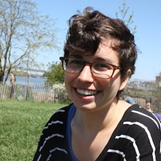Kaitlyn Gaynor, ESPM PhD Student was a Rocca Dissertation Fellow in 2016.
My dissertation research, supported by the CAS Rocca fellowship, examines the interactions between people and wildlife in Gorongosa National Park, Mozambique. After decades of war, Gorongosa’s human and animal populations are recovering and rediscovering how to coexist in a changing landscape. My goal is to use science to inform management solutions for an ongoing restoration project in Gorongosa that promotes conservation and human development in the region.

Trained as an ecologist, I tend to approach conservation questions empirically, and from the perspective of wildlife. But conservation issues like habitat degradation, illegal hunting, and human-wildlife conflict are tightly connected to complex social dynamics—food systems, human health, local culture and history. At both UC Berkeley and Gorongosa, I am fortunate to be surrounded by inspiring people who are thinking creatively about global environmental challenges. Through conversations with social scientists and development practitioners, I have developed a richer picture of Gorongosa’s socioecological dynamics and an appreciation for our need to work together.
One of my Mozambican colleagues, anthropologist Muala, has exposed me to local people’s perceptions of animals. His stories have given me a deeper perspective on the role of wildlife in the park—far beyond what I learned in my textbooks or field guides. Domingos taught me about traditions involving tembo (totems), in which a family adopts certain animals to protect, vowing not to utilize these species. With each family adopting different totems, the full suite of Gorongosa’s wildlife is conserved. Domingos continues to gather this local environmental knowledge and bring leaders into discussions about park management (and has compiled stories into a book, Tales of Gorongosa).
 Meanwhile, my colleagues at UC Berkeley’s Department of Environmental Science, Policy, and Management have provided me with training in interdisciplinary thinking. Most recently, my labmates and fellow PhD candidates Alex McInturff and Lauren Withey organized a symposium, “Conservation and storytelling in a post-truth world,” at the 2017 International Congress for Conservation Biology in Colombia. They gathered scholars to discuss obligations and opportunities for crafting conservation narratives—and, importantly, listening to them.
Meanwhile, my colleagues at UC Berkeley’s Department of Environmental Science, Policy, and Management have provided me with training in interdisciplinary thinking. Most recently, my labmates and fellow PhD candidates Alex McInturff and Lauren Withey organized a symposium, “Conservation and storytelling in a post-truth world,” at the 2017 International Congress for Conservation Biology in Colombia. They gathered scholars to discuss obligations and opportunities for crafting conservation narratives—and, importantly, listening to them.
I was thrilled to participate in this symposium with Domingos, who shared the stories of local African conservation with an international audience in our presentation, “Tete are na nne (Ancient things are today): Integrating local narratives into African conservation.” Just as Domingos had learned from listening to the stories of community members, and I had learned from Domingos, and the international audience of conservation biologists could learn from our experiences in Gorongosa.
Now that I am back on campus, I turn again to the narrow ecological theory that motivates the core of my dissertation research on Gorongosa’s wildlife. But I am reenergized and inspired by the interdisciplinary conversations among my international colleagues, and grateful for the opportunity to step back and situate my research in a larger socioecological context. Conservation in Gorongosa, as in the rest of Africa and the world, will continue to present challenges, but I am optimistic. If we continue to share stories across continents and disciplines, we can develop more creative solutions to conserve the environment for people and all living things.
